Intensive farming
Intensive agriculture, also known as intensive farming (as opposed to extensive farming) and industrial agriculture, is a type of agriculture, both of crop plants and of animals, with higher levels of input and output per cubic unit of agricultural land area. It is characterized by a low fallow ratio, higher use of inputs such as capital and labour, and higher crop yields per unit land area.[1]
| Agriculture |
|---|
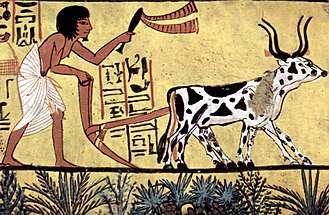 |
|
Categories
|
|
|
Most commercial agriculture is intensive in one or more ways. Forms that rely heavily on industrial methods are often called industrial agriculture, which is characterised by innovations designed to increase yield. Techniques include planting multiple crops per year, reducing the frequency of fallow years, and improving cultivars. It also involves increased use of fertilizers, plant growth regulators, and pesticides and mechanised agriculture, controlled by increased and more detailed analysis of growing conditions, including weather, soil, water, weeds, and pests. This system is supported by ongoing innovation in agricultural machinery and farming methods, genetic technology, techniques for achieving economies of scale, logistics, and data collection and analysis technology. Intensive farms are widespread in developed nations and increasingly prevalent worldwide. Most of the meat, dairy products, eggs, fruits, and vegetables available in supermarkets are produced by such farms.
Some intensive farms can use sustainable methods, although this may necessitate higher inputs of labor or lower yields.[2]
Intensive animal farming involves large numbers of animals raised on limited land, for example by rotational grazing,[3][4] or in the Western world sometimes as concentrated animal feeding operations. These methods increase the yields of food and fiber per acre as compared to extensive animal husbandry; concentrated feed is brought to seldom-moved animals, or with rotational grazing the animals are repeatedly moved to fresh forage.[3][4]
History
_CNE-v1-p58-H.jpg)
Paddy-based rice-farming has been practised in Korea since ancient times. A pit-house at the Daecheon-ni archaeological site yielded carbonized rice grains and radiocarbon dates indicating that rice cultivation may have begun as early as the Middle Jeulmun Pottery Period (c. 3500–2000 BC) in the Korean Peninsula.[5] The earliest rice cultivation there may have used dry-fields instead of paddies.
Agricultural development in Britain between the 16th century and the mid-19th century saw a massive increase in agricultural productivity and net output. This in turn contributed to unprecedented population growth, freeing up a significant percentage of the workforce, and thereby helped enable the Industrial Revolution. Historians cited enclosure, mechanization, four-field crop rotation, and selective breeding as the most important innovations.[6]
Industrial agriculture arose in the Industrial Revolution. By the early 19th century, agricultural techniques, implements, seed stocks, and cultivars had so improved that yield per land unit was many times that seen in the Middle Ages.[7]
The industrialization phase involved a continuing process of mechanization. Horse-drawn machinery such as the McCormick reaper revolutionized harvesting, while inventions such as the cotton gin reduced the cost of processing. During this same period, farmers began to use steam-powered threshers and tractors.[8][9][10] In 1892, the first gasoline-powered tractor was successfully developed, and in 1923, the International Harvester Farmall tractor became the first all-purpose tractor, marking an inflection point in the replacement of draft animals with machines. Mechanical harvesters (combines), planters, transplanters, and other equipment were then developed, further revolutionizing agriculture.[11] These inventions increased yields and allowed individual farmers to manage increasingly large farms.[12]
The identification of nitrogen, phosphorus, and potassium (NPK) as critical factors in plant growth led to the manufacture of synthetic fertilizers, further increasing crop yields. In 1909, the Haber-Bosch method to synthesize ammonium nitrate was first demonstrated. NPK fertilizers stimulated the first concerns about industrial agriculture, due to concerns that they came with side effects such as soil compaction, soil erosion, and declines in overall soil fertility, along with health concerns about toxic chemicals entering the food supply.[13]
The discovery of vitamins and their role in nutrition, in the first two decades of the 20th century, led to vitamin supplements, which in the 1920s allowed some livestock to be raised indoors, reducing their exposure to adverse natural elements.
Following World War II synthetic fertilizer use increased rapidly.[14]
The discovery of antibiotics and vaccines facilitated raising livestock by reducing diseases. Developments in logistics and refrigeration as well as processing technology made long-distance distribution feasible. Integrated pest management is the modern method to minimize pesticide use to more sustainable levels.
There are concerns over the sustainability of industrial agriculture, and the environmental effects of fertilizers and pesticides, which has given rise to the organic movement[15] and has built a market for sustainable intensive farming, as well as funding for the development of appropriate technology.
Techniques and technologies
Livestock
Pasture intensification
Pasture intensification is the improvement of pasture soils and grasses to increase the food production potential of livestock systems. It is commonly used to reverse pasture degradation, a process characterized by loss of forage and decreased animal carrying capacity which results from overgrazing, poor nutrient management, and lack of soil conservation.[16] This degradation leads to poor pasture soils with decreased fertility and water availability and increased rates of erosion, compaction, and acidification.[17] Degraded pastures have significantly lower productivity and higher carbon footprints compared to intensified pastures.[18][19][20][21][22]
Management practices which improve soil health and consequently grass productivity include irrigation, soil scarification, and the application of lime, fertilizers, and pesticides. Depending on the productivity goals of the target agricultural system, more involved restoration projects can be undertaken to replace invasive and under-productive grasses with grass species that are better suited to the soil and climate conditions of the region.[16] These intensified grass systems allow higher stocking rates with faster animal weight gain and reduced time to slaughter, resulting in more productive, carbon-efficient livestock systems.[20][21][22]
Another technique to optimize yield while maintaining the carbon balance is the use of integrated crop-livestock (ICL) and crop-livestock-forestry (ICLF) systems, which combine several ecosystems into one optimized agricultural framework.[23] These synergies between these systems provide benefits to pastures through optimal plant usage, improved feed and fattening rates, increased soil fertility and quality, intensified nutrient cycling, integrated pest control, and improved biodiversity.[16][23] The introduction of certain legume crops to pastures increases carbon accumulation and nitrogen fixation in soils, while their digestibility helps animal fattening and reduces methane emissions from enteric fermentation.[16][20] ICLF systems yield beef cattle productivity up to ten times that of degraded pastures, additional crop production from maize, sorghum, and soybean harvests, and greatly reduced greenhouse gas balances due to forest carbon sequestration.[17]
In the Twelve Aprils grazing program for dairy production, developed by the USDA-SARE forage crops for dairy herds are planted into a perennial pasture.[24]
Rotational grazing
(NRCS_Photo_Gallery).tif.jpg)
Rotational grazing is a variety of foraging in which herds or flocks are regularly and systematically moved to fresh, rested grazing areas (sometimes called paddocks) to maximize the quality and quantity of forage growth. It can be used with cattle, sheep, goats, pigs, chickens, turkeys, ducks, and other animals. The herds graze one portion of pasture, or a paddock, while allowing the others to recover. Resting grazed lands allows the vegetation to renew energy reserves, rebuild shoot systems, and deepen root systems, resulting in long-term maximum biomass production.[3][4][25][26] Pasture systems alone can allow grazers to meet their energy requirements, but rotational grazing is especially effective because grazers thrive on the more tender younger plant stems. Parasites are also left behind to die off, minimizing or eliminating the need for de-wormers. With the increased productivity of rotational systems, the animals may need less supplemental feed than in continuous grazing systems. Farmers can therefore increase stocking rates.[3][27]
Concentrated animal feeding operations
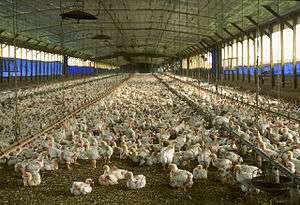
Intensive livestock farming or "factory farming", is the process of raising livestock in confinement at high stocking density.[28][29][30][31][32] "Concentrated animal feeding operations" (CAFO), or "intensive livestock operations", can hold large numbers (some up to hundreds of thousands) of cows, hogs, turkeys, or chickens, often indoors. The essence of such farms is the concentration of livestock in a given space. The aim is to provide maximum output at the lowest possible cost and with the greatest level of food safety.[33] The term is often used pejoratively.[34] However, CAFOs have dramatically increased the production of food from animal husbandry worldwide, both in terms of total food produced and efficiency.
Food and water is delivered to the animals, and therapeutic use of antimicrobial agents, vitamin supplements, and growth hormones are often employed. Growth hormones are not used on chickens nor on any animal in the European Union. Undesirable behaviors often related to the stress of confinement led to a search for docile breeds (e.g., with natural dominant behaviors bred out), physical restraints to stop interaction, such as individual cages for chickens, or physical modification such as the de-beaking of chickens to reduce the harm of fighting.
The CAFO designation resulted from the 1972 U.S. Federal Clean Water Act, which was enacted to protect and restore lakes and rivers to a "fishable, swimmable" quality. The United States Environmental Protection Agency identified certain animal feeding operations, along with many other types of industry, as "point source" groundwater polluters. These operations were subjected to regulation.[35]
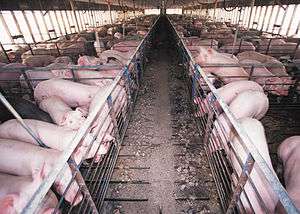
In 17 states in the U.S., isolated cases of groundwater contamination were linked to CAFOs.[36] For example, the ten million hogs in North Carolina generate 19 million tons of waste per year.[37] The U.S. federal government acknowledges the waste disposal issue and requires that animal waste be stored in lagoons. These lagoons can be as large as 7.5 acres (30,000 m2). Lagoons not protected with an impermeable liner can leak into groundwater under some conditions, as can runoff from manure used as fertilizer. A lagoon that burst in 1995 released 25 million gallons of nitrous sludge in North Carolina's New River. The spill allegedly killed eight to ten million fish.[38]
The large concentration of animals, animal waste, and dead animals in a small space poses ethical issues to some consumers. Animal rights and animal welfare activists have charged that intensive animal rearing is cruel to animals.
Crops
The Green Revolution transformed farming in many developing countries. It spread technologies that had already existed, but had not been widely used outside of industrialized nations. These technologies included "miracle seeds", pesticides, irrigation, and synthetic nitrogen fertilizer.[39]
Seeds
In the 1970s, scientists created high-yielding varieties of maize, wheat, and rice. These have an increased nitrogen-absorbing potential compared to other varieties. Since cereals that absorbed extra nitrogen would typically lodge (fall over) before harvest, semi-dwarfing genes were bred into their genomes. Norin 10 wheat, a variety developed by Orville Vogel from Japanese dwarf wheat varieties, was instrumental in developing wheat cultivars. IR8, the first widely implemented high-yielding rice to be developed by the International Rice Research Institute, was created through a cross between an Indonesian variety named "Peta" and a Chinese variety named "Dee Geo Woo Gen".[40]
With the availability of molecular genetics in Arabidopsis and rice the mutant genes responsible (reduced height (rht), gibberellin insensitive (gai1) and slender rice (slr1)) have been cloned and identified as cellular signalling components of gibberellic acid, a phytohormone involved in regulating stem growth via its effect on cell division. Photosynthate investment in the stem is reduced dramatically in shorter plants and nutrients become redirected to grain production, amplifying in particular the yield effect of chemical fertilizers.
High-yielding varieties outperformed traditional varieties several fold and responded better to the addition of irrigation, pesticides, and fertilizers. Hybrid vigour is utilized in many important crops to greatly increase yields for farmers. However, the advantage is lost for the progeny of the F1 hybrids, meaning seeds for annual crops need to be purchased every season, thus increasing costs and profits for farmers.
Crop rotation
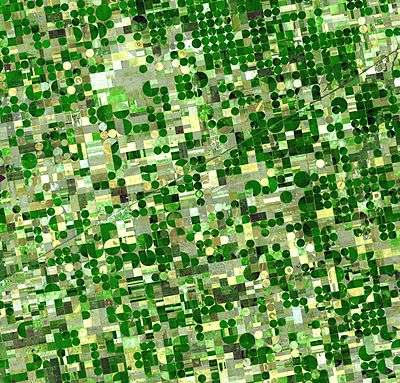
Crop rotation or crop sequencing is the practice of growing a series of dissimilar types of crops in the same space in sequential seasons for benefits such as avoiding pathogen and pest buildup that occurs when one species is continuously cropped. Crop rotation also seeks to balance the nutrient demands of various crops to avoid soil nutrient depletion. A traditional component of crop rotation is the replenishment of nitrogen through the use of legumes and green manure in sequence with cereals and other crops. Crop rotation can also improve soil structure and fertility by alternating deep-rooted and shallow-rooted plants. A related technique is to plant multi-species cover crops between commercial crops. This combines the advantages of intensive farming with continuous cover and polyculture.
Irrigation
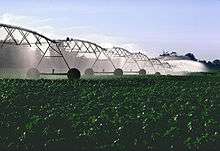
Crop irrigation accounts for 70% of the world's fresh water use.[41] Flood irrigation, the oldest and most common type, is typically unevenly distributed, as parts of a field may receive excess water in order to deliver sufficient quantities to other parts. Overhead irrigation, using center-pivot or lateral-moving sprinklers, gives a much more equal and controlled distribution pattern. Drip irrigation is the most expensive and least-used type, but delivers water to plant roots with minimal losses.
Water catchment management measures include recharge pits, which capture rainwater and runoff and use it to recharge groundwater supplies. This helps in the replenishment of groundwater wells and eventually reduces soil erosion. Dammed rivers creating reservoirs store water for irrigation and other uses over large areas. Smaller areas sometimes use irrigation ponds or groundwater.
Weed control
In agriculture, systematic weed management is usually required, often performed by machines such as cultivators or liquid herbicide sprayers. Herbicides kill specific targets while leaving the crop relatively unharmed. Some of these act by interfering with the growth of the weed and are often based on plant hormones. Weed control through herbicide is made more difficult when the weeds become resistant to the herbicide. Solutions include:
- Cover crops (especially those with allelopathic properties) that out-compete weeds or inhibit their regeneration
- Multiple herbicides, in combination or in rotation
- Strains genetically engineered for herbicide tolerance
- Locally adapted strains that tolerate or out-compete weeds
- Tilling
- Ground cover such as mulch or plastic
- Manual removal
- Mowing
- Grazing
- Burning
Terracing

In agriculture, a terrace is a leveled section of a hilly cultivated area, designed as a method of soil conservation to slow or prevent the rapid surface runoff of irrigation water. Often such land is formed into multiple terraces, giving a stepped appearance. The human landscapes of rice cultivation in terraces that follow the natural contours of the escarpments, like contour ploughing, are a classic feature of the island of Bali and the Banaue Rice Terraces in Banaue, Ifugao, Philippines. In Peru, the Inca made use of otherwise unusable slopes by building drystone walls to create terraces.
Rice paddies
A paddy field is a flooded parcel of arable land used for growing rice and other semiaquatic crops. Paddy fields are a typical feature of rice-growing countries of east and southeast Asia, including Malaysia, China, Sri Lanka, Myanmar, Thailand, Korea, Japan, Vietnam, Taiwan, Indonesia, India, and the Philippines. They are also found in other rice-growing regions such as Piedmont (Italy), the Camargue (France), and the Artibonite Valley (Haiti). They can occur naturally along rivers or marshes, or can be constructed, even on hillsides. They require large water quantities for irrigation, much of it from flooding. It gives an environment favourable to the strain of rice being grown, and is hostile to many species of weeds. As the only draft animal species which is comfortable in wetlands, the water buffalo is in widespread use in Asian rice paddies.[42]
A recent development in the intensive production of rice is the System of Rice Intensification.[43][44] Developed in 1983 by the French Jesuit Father Henri de Laulanié in Madagascar,[45] by 2013 the number of smallholder farmers using the system had grown to between 4 and 5 million.[46]
Aquaculture
Aquaculture is the cultivation of the natural products of water (fish, shellfish, algae, seaweed, and other aquatic organisms). Intensive aquaculture takes place on land using tanks, ponds, or other controlled systems, or in the ocean, using cages.[47][47]
Sustainability
Intensive farming practices which are thought to be sustainable have been developed to slow the deterioration of agricultural land and even regenerate soil health and ecosystem services. These developments may fall in the category of organic farming, or the integration of organic and conventional agriculture.
Pasture cropping involves planting grain crops directly into grassland without first applying herbicides. The perennial grasses form a living mulch understory to the grain crop, eliminating the need to plant cover crops after harvest. The pasture is intensively grazed both before and after grain production. This intensive system yields equivalent farmer profits (partly from increased livestock forage) while building new topsoil and sequestering up to 33 tons of CO2/ha/year.[48][49]
Biointensive agriculture focuses on maximizing efficiency such as per unit area, energy input and water input.
Agroforestry combines agriculture and orchard/forestry technologies to create more integrated, diverse, productive, profitable, healthy and sustainable land-use systems.
Intercropping can increase yields or reduce inputs and thus represents (potentially sustainable) agricultural intensification. However, while total yield per acre is often increased, yields of any single crop often diminish. There are also challenges to farmers relying on farming equipment optimized for monoculture, often resulting in increased labor inputs.
Vertical farming is intensive crop production on a large scale in urban centers, in multi-story, artificially-lit structures, for the production of low-calorie foods like herbs, microgreens, and lettuce.
An integrated farming system is a progressive, sustainable agriculture system such as zero waste agriculture or integrated multi-trophic aquaculture, which involves the interactions of multiple species. Elements of this integration can include:
- Intentionally introducing flowering plants into agricultural ecosystems to increase pollen-and nectar-resources required by natural enemies of insect pests[50]
- Using crop rotation and cover crops to suppress nematodes in potatoes[51]
- Integrated multi-trophic aquaculture is a practice in which the by-products (wastes) from one species are recycled to become inputs (fertilizers, food) for another.
Holistic management was originally developed for reversing desertification.[52] Holistic planned grazing is similar to rotational grazing but accentuates the four principles of the water cycle, the mineral cycles (including the carbon cycle),[53] energy flow and ecology.[54]
Challenges
[W]hen hunter-gatherers with growing populations depleted the stocks of game and wild foods across the Near East, they were forced to introduce agriculture. But agriculture brought much longer hours of work and a less rich diet than hunter-gatherers enjoyed. Further population growth among shifting slash-and-burn farmers led to shorter fallow periods, falling yields and soil erosion. Plowing and fertilizers were introduced to deal with these problems—but once again involved longer hours of work and degradation of soil resources.[55]
The challenges and issues of industrial agriculture for society, for the sector, and for animal rights, include the costs and benefits of both current practices and proposed changes to those practices.[56][57] This is a continuation of thousands of years of invention in feeding growing populations.
Population growth
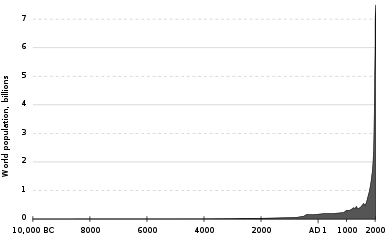
Very roughly:
- 30,000 years ago hunter-gatherer behavior fed 6 million people
- 3,000 years ago primitive agriculture fed 60 million people
- 300 years ago a more intensive agriculture fed 600 million people
- Today industrial agriculture attempts to feed 8 billion people
Between 1930 and 2000, U.S. agricultural productivity (output divided by all inputs) rose by an average of about 2 percent annually, causing food prices to decrease. "The percentage of U.S. disposable income spent on food prepared at home decreased, from 22 percent as late as 1950 to 7 percent by the end of the century."[58]
Other impacts
Environmental
Industrial agriculture uses huge amounts of water, energy,[59] and industrial chemicals, increasing pollution in the arable land, usable water, and atmosphere. Herbicides, insecticides, and fertilizers accumulate in ground and surface waters. Industrial agricultural practices are one of the main drivers of global warming, accounting for 14–28% of net Greenhouse-gas emissions.[60]
Many of the negative effects of industrial agriculture may emerge at some distance from fields and farms. Nitrogen compounds from the Midwest, for example, travel down the Mississippi to degrade coastal fisheries in the Gulf of Mexico, causing so-called oceanic dead zones.[61]
But other adverse effects show up within agricultural production systems—for example, the rapidly developing resistance among pests renders herbicides and insecticides increasingly ineffective.[62] Agrochemicals have been implicated in Colony collapse disorder, in which the individual members of bee colonies disappear.[63] (Agricultural production is highly dependent on bees to pollinate many varieties of fruits and vegetables.)
Intensive monoculture increases the risk of failures due to pests, adverse weather and disease.[64][65]
Social
A study for the U.S. Office of Technology Assessment concluded that regarding industrial agriculture, there is a "negative relationship between the trend toward increasing farm size and the social conditions in rural communities" on a "statistical level".[66] Agricultural monoculture can entail social and economic risks.[67]
See also
- Convertible husbandry
- Dryland farming
- Environmental issues with agriculture
- Green Revolution
- Pekarangan
- Small-scale agriculture
- Intensive animal farming
References
- Encyclopædia Britannica, revised and updated by Amy Tikkanen. "'s definition of Intensive Agriculture". britannica.com.
- Lichtfouse, Eric; Navarrete, Mireille; Debaeke, Philippe; Souchère, Véronique; Alberola, Caroline, eds. (2009). Sustainable Agriculture (PDF). Dordrecht: Springer. p. 5. doi:10.1007/978-90-481-2666-8. ISBN 978-90-481-2665-1.
- Undersander, Dan; Albert, Beth; Cosgrove, Dennis; Johnson, Dennis; Peterson, Paul (2002). Pastures for profit: A guide to rotational grazing (PDF) (Report). Cooperative Extension Publishing, University of Wisconsin. p. 4. A3529. Retrieved 21 September 2019.
rotational grazing involves a higher level of management with greater paddock numbers, shorter grazing periods, and longer rest periods.
- "Getting Started with Intensive Grazing". Manitoba Agriculture. Manitoba Government. Retrieved 21 September 2019.
There are many reasons why producers move to intensive grazing systems. These include...
- Crawford, Gary W.; Lee, Gyoung-Ah (2003). "Agricultural origins in the Korean Peninsula". Antiquity. 77 (295): 87–95.
-
- Overton, Mark. Agricultural Revolution in England 1500–1850 (September 19, 2002), BBC.
- Valenze, Deborah. The First Industrial Woman (New York: Oxford University Press, 1995), p. 183.
- Kagan, Donald. The Western Heritage (London: Prentice Hall, 2004), pp. 535–539.
- Kingsbury, Noel (2009). Hybrid: The History and Science of Plant Breeding. University of Chicago Press. ISBN 978-0226437132.
- Brettman, Allan (July 24, 2010). "Collectors at Great Oregon Steam-Up are always steamed about their passion". The Oregonian.
- "Ottawa Valley Land Rovers – Member's Prose & Pages – Mike Rooth – Locomotives – Steam Tractor, Part I". ovlr.org.
- "Steam Engines". History Link 101. History Source LLC. 2019. Retrieved 20 September 2019.
- Janick, Jules. "Agricultural Scientific Revolution: Mechanical" (PDF). Purdue University. Retrieved 2013-05-24.
- Reid, John F. (Fall 2011). "The Impact of Mechanization on Agriculture". The Bridge on Agriculture and Information Technology. 41 (3).
- Stinner, D.H (2007). "The Science of Organic Farming". In William Lockeretz (ed.). Organic Farming: An International History. Oxfordshire, UK & Cambridge, Massachusetts: CAB International (CABI). ISBN 978-0-85199-833-6. Retrieved 30 April 2013. (ebook ISBN 978-1-84593-289-3}
- "A Historical Perspective". International Fertilizer Industry Association. Archived from the original on 2012-03-09. Retrieved 2013-05-07.
- Philpott, Tom (19 April 2013). "A Brief History of Our Deadly Addiction to Nitrogen Fertilizer". Mother Jones.
- Zimmer, Ademir; Macedo, Manuel; Neivo Kichel, Armindo; Almeida, Roberto (2012-11-01). Degradação, recuperação e renovação de pastagens.
- de Figueiredo, Eduardo Barretto; Jayasundara, Susantha; Bordonal, Ricardo de Oliveira; Berchielli, Telma Teresinha; Reis, Ricardo Andrade; Wagner-Riddle, Claudia; Jr., Newton La Scala (2017). "Greenhouse gas balance and carbon footprint of beef cattle in three contrasting pasture-management systems in Brazil". Journal of Cleaner Production. 142: 420–431. doi:10.1016/j.jclepro.2016.03.132. hdl:11449/177967.
- "Indicativo de pastagens plantadas em processo de degradação no bioma Cerrado". embrapa.br – Portal Embrapa (in Portuguese). Retrieved 2018-03-28.
- Bogaerts, Meghan; Cirhigiri, Lora; Robinson, Ian; Rodkin, Mikaela; Hajjar, Reem; Junior, Ciniro Costa; Newton, Peter (2017). "Climate change mitigation through intensified pasture management: Estimating greenhouse gas emissions on cattle farms in the Brazilian Amazon". Journal of Cleaner Production. 162: 1539–1550. doi:10.1016/j.jclepro.2017.06.130.
- Cardoso, Abmael S.; Berndt, Alexandre; Leytem, April; Alves, Bruno J. R.; Carvalho, Isabel das N.O. de; Soares, Luis Henrique de Barros; Urquiaga, Segundo; Boddey, Robert M. (2016). "Impact of the intensification of beef production in Brazil on greenhouse gas emissions and land use" (PDF). Agricultural Systems. 143: 86–96. doi:10.1016/j.agsy.2015.12.007.
- Talamini, Edson; Ruviaro, Clandio Favarini; Florindo, Thiago José; Florindo, Giovanna Isabelle Bom De Medeiros (2017). "Improving feed efficiency as a strategy to reduce beef carbon footprint in the Brazilian Midwest region". International Journal of Environment and Sustainable Development. 16 (4): 379. doi:10.1504/ijesd.2017.10007706.
- Ruviaro, Clandio F.; Léis, Cristiane Maria de; Lampert, Vinícius do N.; Barcellos, Júlio Otávio Jardim; Dewes, Homero (2015). "Carbon footprint in different beef production systems on a southern Brazilian farm: a case stud" (PDF). Journal of Cleaner Production. 96: 435–443. doi:10.1016/j.jclepro.2014.01.037. hdl:10183/122628.
- Balbino, Luiz; Neivo Kichel, Armindo; Bungenstab, Davi; Almeida, Roberto (2014-03-01). Integrated systems: what they are, their advantages and limitations. pp. 11–18. ISBN 9788570352972.
- "12 Aprils Dairy Grazing Manual". USDA-SARE. Retrieved 1 October 2014.
- Beetz, A. E. (2004). Rotational grazing: Livestock systems guide. National Sustainable Agriculture Information Service (ATTRA).
- Sanjari, G.; Ghadiri, H.; Ciesiolka, C. A. A.; Yu, B. (2008). "Comparing the effects of continuous and time-controlled grazing systems on soil characteristics in Southeast Queensland" (PDF). Soil Research 46 (CSIRO Publishing). pp. 48–358.
- Teague, W. R.; Dowhowera, S. L.; Bakera, S. A.; Haileb, N.; DeLaunea, P. B.; Conovera, D. M. (May 2011). "Grazing management impacts on vegetation, soil biota and soil chemical, physical and hydrological properties in tall grass prairie". Agriculture, Ecosystems & Environment. 141 (3–4): 310–322. doi:10.1016/j.agee.2011.03.009.
- Sources discussing "intensive farming", "intensive agriculture" or "factory farming":
- Fraser, David. Animal welfare and the intensification of animal production: An alternative interpretation, Food and Agriculture Organization of the United Nations, 2005.
- Turner, Jacky. "History of factory farming" Archived 2013-11-16 at the Wayback Machine, United Nations: "Fifty years ago in Europe, intensification of animal production was seen as the road to national food security and a better diet ... The intensive systems—called 'factory farms'—were characterised by confinement of the animals at high stocking density, often in barren and unnatural conditions."
- Humphrys, John. Why the organic revolution had to happen, The Observer, April 21, 2001: "Nor is a return to 'primitive' farming practices the only alternative to factory farming and highly intensive agriculture."
- Baker, Stanley. "Factory farms – the only answer to our growing appetite?, The Guardian, December 29, 1964: "Factory farming, whether we like it or not, has come to stay ... In a year which has been as uneventful on the husbandry side as it has been significant in economic and political developments touching the future of food procurement, the more far-seeing would name the growth of intensive farming as the major development." (Note: Stanley Baker was the Guardian's agriculture correspondent.)
- "Head to head: Intensive farming", BBC News, March 6, 2001: "Here, Green MEP Caroline Lucas takes issue with the intensive farming methods of recent decades ... In the wake of the spread of BSE from the UK to the continent of Europe, the German Government has appointed an Agriculture Minister from the Green Party. She intends to end factory farming in her country. This must be the way forward and we should end industrial agriculture in this country as well."
- Sources discussing "industrial farming", "industrial agriculture" and "factory farming":
- "Annex 2. Permitted substances for the production of organic foods", Food and Agriculture Organization of the United Nations: "'Factory' farming refers to industrial management systems that are heavily reliant on veterinary and feed inputs not permitted in organic agriculture.
- "Head to head: Intensive farming", BBC News, March 6, 2001: "Here, Green MEP Caroline Lucas takes issue with the intensive farming methods of recent decades ... In the wake of the spread of BSE from the UK to the continent of Europe, the German Government has appointed an Agriculture Minister from the Green Party. She intends to end factory farming in her country. This must be the way forward and we should end industrial agriculture in this country as well."
- Kaufmann, Mark. "Largest Pork Processor to Phase Out Crates", The Washington Post, January 26, 2007.
- "EU tackles BSE crisis", BBC News, November 29, 2000.
- "Is factory farming really cheaper?" in New Scientist, Institution of Electrical Engineers, New Science Publications, University of Michigan, 1971, p. 12.
- Danielle Nierenberg (2005) Happier Meals: Rethinking the Global Meat Industry. Worldwatch Paper 121: 5
- Duram, Leslie A. (2010). Encyclopedia of Organic, Sustainable, and Local Food. ABC-CLIO. p. 139. ISBN 978-0-313-35963-7.
- Sweeten, John et al. "Fact Sheet #1: A Brief History and Background of the EPA CAFO Rule". MidWest Plan Service, Iowa State University, July 2003.
- "CAFOs & Clean Water Act". Archived from the original on 2013-11-05. Retrieved 2013-11-05.
- "North Carolina's Hog Waste Lagoons: A Public Health Time Bomb". edf.org.
- Orlando, Laura. McFarms Go Wild, Dollars and Sense, July/August 1998, cited in Scully, Matthew. Dominion, St. Martin's Griffin, p. 257.
- Brown, 1970.
- "Rice Varieties". IRRI Knowledge Bank. Archived from the original on 2006-07-13. Retrieved 2006-07-13.
- Pimentel, Berger, et al., "Water resources: agricultural and environmental issues", BioScience 54.10 (Oct 2004), p909
- "Methane – Rice". ghgonline.org.
- "SRI Concepts and Methods Applied to Other Crops". Cornell University. Retrieved 1 October 2014.
- "The System of Crop Intensification Agroecological Innovations for Improving Agricultural Production, Food Security, and Resilience to Climate Change" (PDF). SRI International Network and Resources Center. Cornell University. Retrieved 1 October 2014.
- Intensive Rice Farming in Madagascar by H. De Laulanié, in Tropicultura, 2011, 29, 3, 183–187
- Vidal, John (16 February 2013). "India's rice revolution". The Observer. The Guardian.
- Answers. "Agriculture". Answers.com.
- Leu, Andre. "Mitigating Climate Change With Soil Organic Matter in Organic Production Systems" (PDF). Trade and environment review 2013, Commentary V. UNCTAD. pp. 22–32. Retrieved 28 September 2014.
- Bradley, Kirsten. "Why Pasture Cropping is such a Big Deal". Milkwood. Retrieved 10 January 2014.
- Oregon State University – Integrated Farming Systems – Insectary Plantings – Enhancing Biological Control with Beneficial Insectary Plants Archived 2006-06-15 at the Wayback Machine
- Oregon State University – Integrated Farming Systems – Nematode Suppression by Cover Crops Archived 2008-09-05 at the Wayback Machine
- Coughlin, Chrissy (2013-03-11). "Allan Savory: How livestock can protect the land". GreenBiz. Retrieved 5 April 2013.
- Schwartz, Judith D. "Soil as Carbon Storehouse: New Weapon in Climate Fight?". Yale Environment 360. Yale School of Forestry & Environmental Studies. Retrieved 25 June 2014.
- Archer, Steve; Smeins, Fred E. Grazing Management an ecological perspective edited by Rodney K Heitschmidt and Jerry W Stuth. p. Chapter 5.
- Boserup, The Conditions of Agricultural Growth, Allen and Unwin, 1965, expanded and updated in Population and Technology, Blackwell, 1980
- Kershen, Drew L. "The contested vision for agriculture's future: Sustainable Intensive Agriculture and Agroecology." Creighton L. Rev. 46 (2012): 591.
- Beirne, Piers. "For a nonspeciesist criminology: Animal abuse as an object of study." Criminology 37.1 (1999): 117-148.
- "U.S. Agriculture in the Twentieth Century by Bruce Gardner, University of Maryland". Archived from the original on September 28, 2013.
- "Moseley, W.G. 2011. "Make farming energy efficient". Atlanta Journal-Constitution. June 3. pg. 15A". ajc.com.
- Mbow, C.; Rosenzweig, C.; Barioni, L. G.; Benton, T.; et al. (2019). "Chapter 5: Food Security" (PDF). IPCC SRCCL. pp. 439–442.
- "What is a dead zone?". NOAA. Retrieved 18 April 2015.
The largest hypoxic zone in the United States, and the second largest hypoxic zone worldwide, forms in the northern Gulf of Mexico adjacent to the Mississippi River. This image from a NOAA animation shows how runoff from farms (green areas) and cities (red areas) drains into the Mississippi. This runoff contains an overabundance of nutrients from fertilizers, wastewater treatment plants, and other sources.
- Union of Concerned Scientists Archived 2008-05-15 at the Wayback Machine article The Costs and Benefits of Industrial Agriculture last updated March 2001. "Many of the negative effects of industrial agriculture are remote from fields and farms. Nitrogen compounds from the Midwest, for example, travel down the Mississippi to degrade coastal fisheries in the Gulf of Mexico. But other adverse effects are showing up within agricultural production systems—for example, the rapidly developing resistance among pests rendering our arsenal of herbicides and insecticides increasingly ineffective."
- Loarie, Greg (2014-05-02). "The Case of the Vanishing Bees". EarthJustice. Retrieved 18 April 2015.
- For example:Berbee, J. G.; Omuemu, J. O.; Martin, R. R.; Castello, J. D. (1976). "Detection and elimination of viruses in poplars". Intensive Plantation Culture: Five Years Research. USDA Forest Service general technical report NC. 21. St. Paul, Minnesota: U.S. Department of Agriculture, Forest Service, North Central Forest Experiment Station. p. 85.
In the north-central States, the intensive culture of certain species and hybrids of poplars presents the greatest opportunity to achieve maximum wood fiber production, provided that adequate provision can be made for control of the many insects and diseases that may attack them. [...] The [...] trend toward monoculture [...] increases the vulnerability of the cropping system to insects and diseases. The greatest potential for insidious disaster due to virus diseases is with monocultures of vegetatively propagated perennial crops.
- Mander, Jerry (2002). "Industrializing Nature and Agriculture". In Kimbrell, Andrew (ed.). The Fatal Harvest Reader: The Tragedy of Industrial Agriculture. Washington: Island Press. p. 89. ISBN 9781597262804. Retrieved 30 November 2019.
Industrial monocultures—single crops where there was once diversity, and single varieties of each crop where there used to be thousands—are also blows against biological and genetic diversity. [...] Monocultures are weak, subject to insect blights, diseases, and bad weather.
- Macrosocial Accounting Project, Dept. of Applied Behavioral Sciences, Univ. of California, Davis, CA Archived 2003-01-21 at the Wayback Machine
-
United States. Department of Agriculture (1973). Monoculture in Agriculture: Extent, Causes, and Problems-report of the Task Force on Spatial Heterogeneity in Agricultural Landscapes and Enterprises. p. 29. Retrieved 30 November 2019.
In addition to being relatively unstable agricultural ecosystems, monocultures are also vulnerable to disaster from social and economic disruptions.
External links
- Fall 2012 Farm Values Report
- "An expansion of the demographic transition model: the dynamic link between agricultural productivity and population" (PDF). Russel Hopfenberg, Psychiatry and Behavioral Sciences Department, Duke University, USA. Journal Biodiversity, Taylor & Francis Online.
.jpg)
